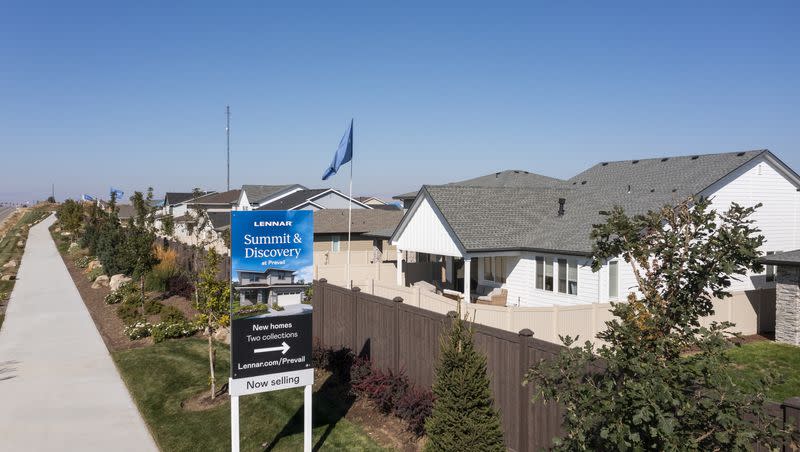Boise housing market down the most in U.S. These Utah markets rank close behind

The U.S. housing market is continuing to undergo a divided real estate correction, with prices rising in the East, while prices are down in many areas in the West.
The West was ground zero for the pandemic housing frenzy when low interest rates and new remote work opportunities sent homebuyers looking for bigger homes at lower price points. But now, after mortgage rates shot up amid the Federal Reserve’s efforts to tamp down inflation, the West was the first to see home prices dip and continues to see negative gains while eastern markets have slowly ticked up.
One western city in particular has been hit the hardest and leads the nation with the largest year-over-year decline: Boise, Idaho.
That’s according to a recent Fortune analysis of the latest reading by the Freddie Mac House Price Index, which shows Boise had the largest year-over-year negative price shift among the 100 largest U.S. housing markets in June, with prices down 10.5% from the peak in June 2022.
LEFT: 10 housing markets up the most year-over-year—and 10 down the most YoY
RIGHT: Shift in home prices between June 2022 and June 2023 (YoY)
Source: Freddie Mac House Price Indexhttps://t.co/327LpbzZYo pic.twitter.com/NU8hn8wJCP— Lance Lambert (@NewsLambert) August 5, 2023
When the housing market started to tip last year, Boise was among the first cities to see a year-over-year home value decline in Zillow’s Home Value Index. The city saw a slight, -1.2% dip according to the index’s seasonally-adjusted data through Aug. 31, with a typical home value of $515,432, down from $521,690 as of Aug. 31, 2021.
Ahead of the national housing market correction, Boise caught national attention for months as housing researchers at Florida Atlantic University ranked it high as one of the most “overvalued” housing markets. Moody’s Analytics also deemed it the nation’s most “overvalued,” saying Boise home prices are nearly 72% overvalued based on market fundamentals. In July 2022, Boise led the nation with the largest share of sellers slashing their prices, as nearly 70% of homes for sale saw price drops.
As prices started to tip negative in Boise, Fortune termed it as an “early-inning housing bust” noting “bubbly” markets, while they’ve been at the highest risk of home price corrections, also saw inventory levels spike. Homebuilders in Boise raced to meet demand, then cut prices when interest rates skyrocketed and scattered buyers.
Still, Boise’s price decline needs to be put in context with the double-digit, year-over-year price growth the metro was seeing in the middle of the pandemic housing madness. In August 2021, that $506,201 typical value was almost 45% up year-over-year from $349,505 in 2020, according to Zillow’s raw index. In July 2021, Boise home prices were up over 47% year over year, according to Zillow.
Related
Where does Utah housing market rank?
Two markets in Utah were also among those that saw the biggest yearly price declines: Ogden, down 3.8% year over year, and Provo, down 3.5%, according to the Freddie Mac House Price Index.
Though Boise burned hotter amid the COVID-19 housing market rush, Utah wasn’t far off. The rapidly growing state, while also dealing with a yearslong housing shortage, also saw prices skyrocket, then taper.
In Salt Lake County, Utah’s most populated county, the median single-family home price jumped nearly 60% from March 2020 to May 2022, when it peaked at $650,000, according to the Salt Lake Board of Realtors. Then when the correction hit, the median home price dropped, bottoming in January at $535,700, a more than 17% reduction.
Prices have started climbing again since then. In June, the median single-family Salt Lake County home sold for $600,000, a nearly 8% year-over-year reduction but a 12% increase from January.
Related
What’s happening in the West?
Compared to the West, Eastern markets have seen a more muted impact from the pandemic housing rush and its ensuing hangover. They’ve been the first to slowly bounce back amid higher interest rates, while the West is still coming to terms with its new realities.
Following Boise, the other nine markets that have seen the most significant declines are: Austin (-10.2%); Phoenix (-6.5%); Honolulu (-5.1%); Las Vegas (-5.0%); Ogden, Utah (-3.8%); Stockton, California (-3.7%); Provo, Utah (-3.5%); Sacramento (-3.5%); and Spokane, Washington (-3.3%), Fortune reported.
These markets have been most impacted because the West and its housing markets have shown “heightened sensitivity to interest rates,” Fortune reported.
“These Western housing markets not only have a significant concentration of rate-sensitive industries, particularly the tech sector, but their elevated home prices in relation to local rents and incomes render them more susceptible to corrections in prices triggered by mortgage rate shocks,” Fortune wrote. “The frothy home prices were a consequence of a pronounced housing shortage spanning a decade in the Western region, coupled with a simultaneous tech boom that propelled Western markets to outperform their counterparts between 2012 and 2021.”
Related

